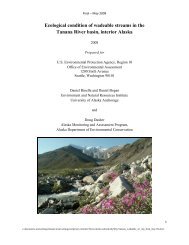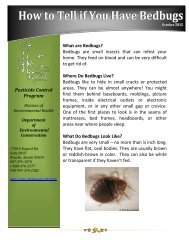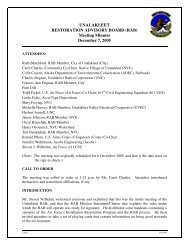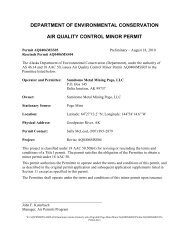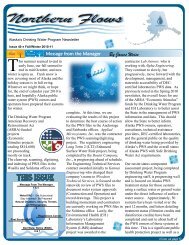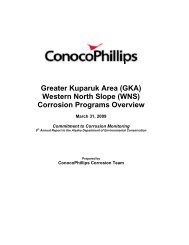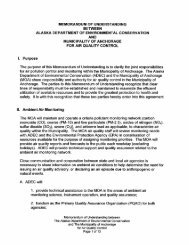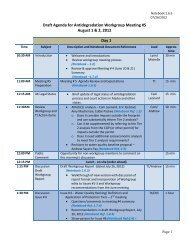2012 Ocean Ranger Guidebook Revision 3-7-12 - Alaska ...
2012 Ocean Ranger Guidebook Revision 3-7-12 - Alaska ...
2012 Ocean Ranger Guidebook Revision 3-7-12 - Alaska ...
Create successful ePaper yourself
Turn your PDF publications into a flip-book with our unique Google optimized e-Paper software.
<strong>20<strong>12</strong></strong> <strong>Ocean</strong> <strong>Ranger</strong> <strong>Guidebook</strong> 3-7-<strong>12</strong><br />
The methods and products used for deck cleaning vary. In particular the teak decks and wood composite<br />
decks are cleaned with special cleaners. It would be useful to check these products.<br />
Most vessels do not perform painting operations in SE <strong>Alaska</strong>. Most is this related to the weather<br />
conditions (rain). However, it appears that some operators do touch up painting on vessels, in particular<br />
the outside hull scantlings which are in direct sight. Mostly these operations are performed in Skagway<br />
and Juneau. Good indicators are the cherry pickers on the docks.<br />
Citation: EPA VGP 2.2.1 Deck Washdown and Runoff and Above Water Line Hull Cleaning<br />
Vessel owner/operators must minimize the introduction of on-deck debris, garbage, residue and spill into deck<br />
washdown and runoff discharges. When required by their class societies (e.g., oil tankers), their flag<br />
Administrations, or the U.S. Coast Guard, vessels must be fitted with and use perimeter spill rails and scuppers to<br />
collect the runoff for treatment. Where feasible, machinery on deck must have coamings or drip pans to collect<br />
any oily water from machinery and prevent spills. The drip pans must be drained to a waste container for proper<br />
disposal and/or periodically wiped and cleaned. The presence of floating solids, visible foam, halogenated phenol<br />
compounds, and dispersants, or surfactants in deck washdowns must be minimized. Vessel operators must<br />
minimize deck washdowns while in port.<br />
Vessel operators must maintain their topside surface and other above water line portions of the vessel to minimize<br />
the discharge of rust (and other corrosion by-products), cleaning compounds, paint chips, non-skid material<br />
fragments, and other materials associated with exterior topside surface preservation. Furthermore, vessel<br />
owner/operators must minimize residual paint droplets from entering waters subject to this permit whenever they<br />
are conducting maintenance painting. Possible minimization techniques include, but are not limited to, avoiding<br />
paint spraying in windy conditions or avoiding overapplication of paint. This permit does not authorize the disposal<br />
of unused paint into waters subject to this permit.<br />
If deck washdowns or above water line hull cleaning will result in a discharge, they must be conducted<br />
with non-toxic and phosphate free cleaners and detergents. Furthermore, cleaners and detergents<br />
should not be caustic or only minimally caustic and should be biodegradable.<br />
Section 1: Subsection 3: Discharge vessels general<br />
Job Aid Item: 1.3.a<br />
Text: Approved Vessel Specific Sampling Plan onboard, up-to-date and available (AS 18AAC 69.025(f) /<br />
33 CFR 157.317(b/General Permit)<br />
What to check for: The VSSP is carried onboard and is available. The VSSP should be checked in the<br />
seasonal report. For regular checks, check the VSSP if changes have been made- for example to tanks<br />
used, or types of WW treated.<br />
Background: The purpose of the VSSP is to explain how samples are taken so they are representative of<br />
typical wastewater treatment process. Inaccuracies have been found in VSSPs, often when changes are<br />
made onboard. The VSSP needs to be available as a reference. A copy of a sample VSSP is included as<br />
wastewater example 2.<br />
Citations:<br />
25






